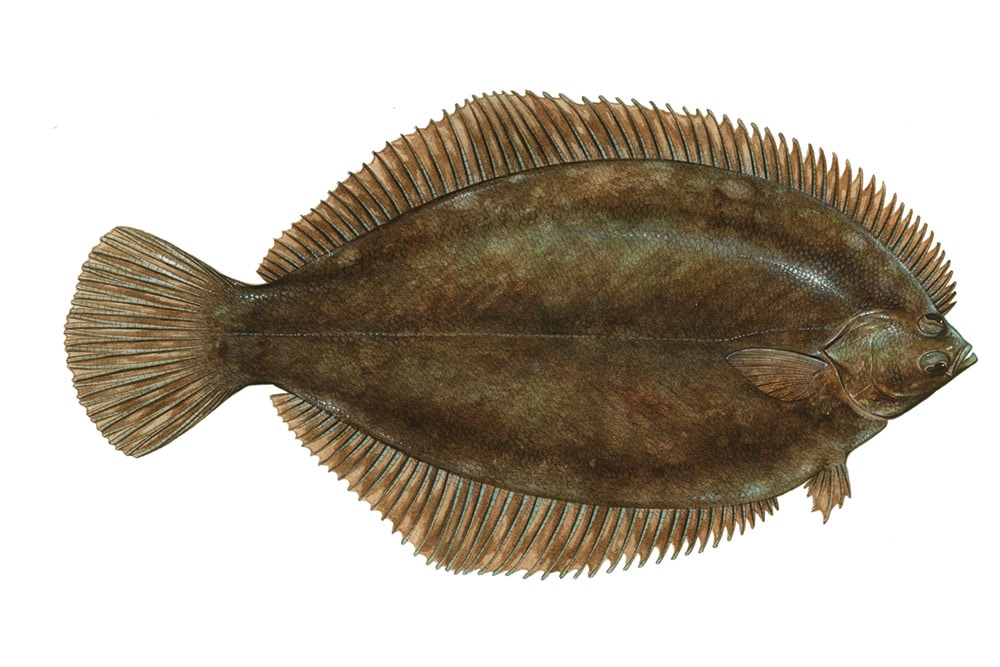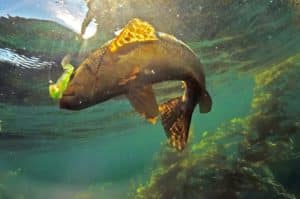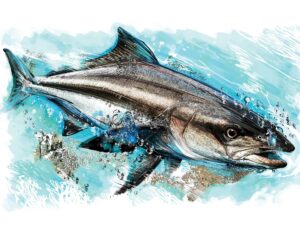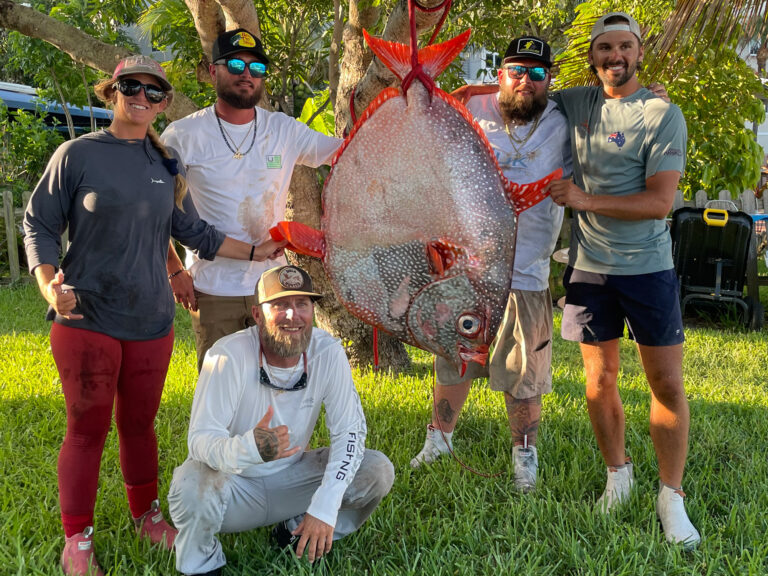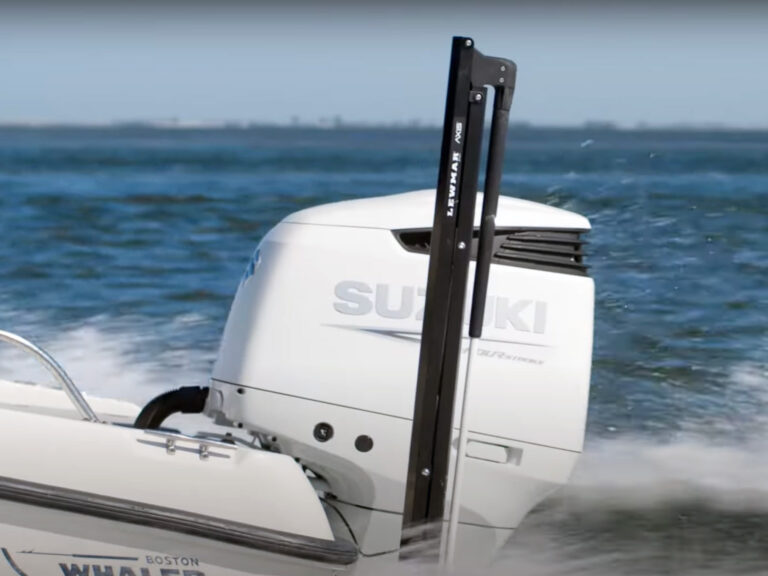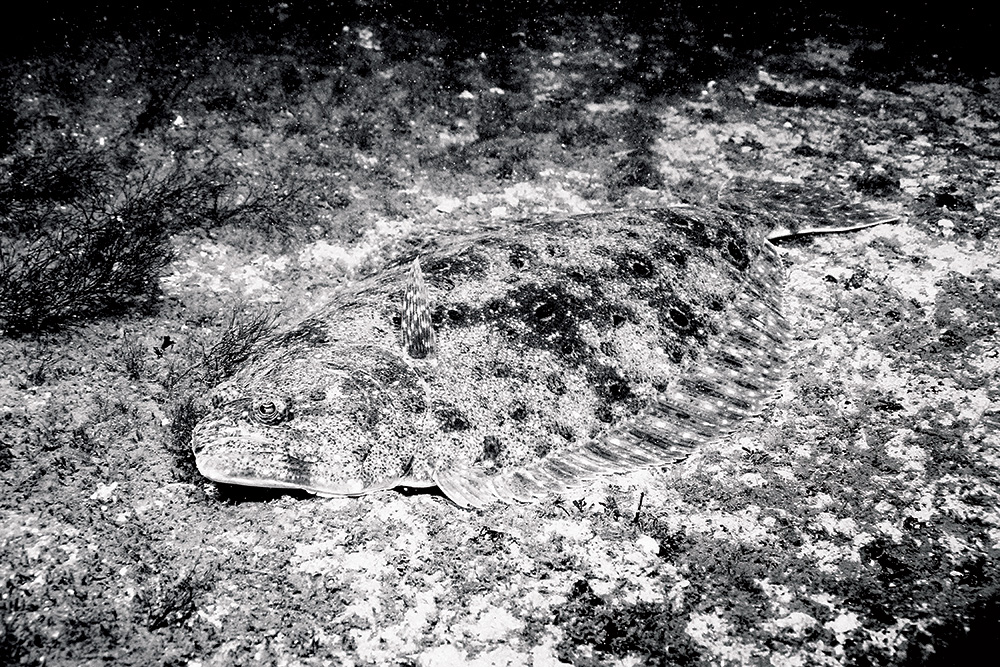
While a common mantra for catching flounder — “fish near the bottom, stupid” — is mostly true, being tuned in to exceptions and nuances increases the odds of bagging big flatties.
No one’s better at doing just that than top flounder fishing guides and pros. Questions we asked included what are the best flounder rigs, what’s the best bait for flounder, where can we catch flounder, and when is the best time to catch them. Here’s what the 10 experts said.
Catching Flounder in Maine
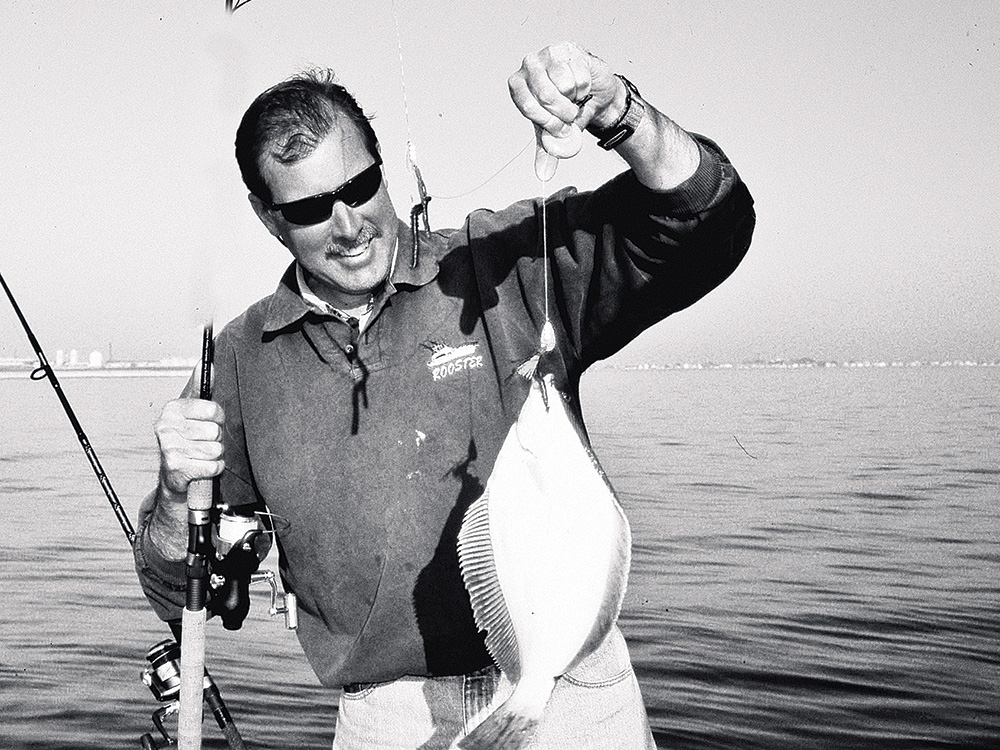
- Expert: Barry Gibson
- Region: Booth Bay Harbor, Maine
- Species: Winter flounder (known as “blackbacks” locally)
The late Barry Gibson spent decades targeting winter flounder. In fact, it was easy to spot his 28-foot Whitewater during the hot flounder months of July through September. “Area tides don’t make a lot of difference,” said Gibson. “Flounder like moving water around coves, estuaries and inlets that present fairly deep centers and shallow fringes. A sand or gravel bottom is ideal, but they’ll also feed over mud and grassy areas as well as mussel beds and creeks that empty into deeper water.
Maine Flounder Fishing Tips
- Go Zobo: Fish a Zobo rig developed by Pete Santini, a tackle-shop owner in Everett, Massachusetts. It’s essentially a high-low rig with hooks and 2- or 3-ounce sinkers painted orange or yellow for more visual appeal.
- Seduce with Sandworms: The best bait for flounder is a 3-inch section of a live sandworm. To make the worms less slippery, put them in a plastic container half filled with corn meal.
- Move It: Blackbacks feed more by sight than scent; try moving the bait a few inches at a time.
Catching Flounder in Massachusetts

- Expert: Capt. Jason Colby
- Region: Boston Harbor and Quincy Bay
- Species: Winter flounder
Catches of winter flounder weighing 3 pounds or more often reward anglers fishing with Capt. Jason Colby. You can find him aboard his 31-foot Contender with dual 300-hp Yamahas. He says the best months for winter flounder are May, June and July, and August to September for summer flounder, aka fluke. (Colby says summer flounder are encountered more often during August and September past Cape Cod.) Colby prefers no wind, but a light breeze with the tide works fine. “Generally, I drift over smooth bottom and anchor where there’s structure,” he says.
Massachusetts Flounder Fishing Tips
- Drop Down: Flounder tend to gather on the deeper side of a ledge, especially on a falling tide, around creek mouths that feed into larger bodies of water. Sometimes flounder follow baits to an anchored boat, so periodically drop straight down.
- A Puff of Mud: When chumming in a current over mud or sand, bounce your flounder rig on the bottom: Lift it 2 inches, and drop it suddenly. That creates a particulate puff each time the sinker hits, and blackbacks hustle over.
- Clam Up: Colby’s consistent success often relies on a two-hook tandem rig with one leader a little longer than the other. Put a clam on the shorter hook and a worm on the longer one — more flounder will go for the worm, but the clam is likely to attract the big boys.
Catching Flounder in New Jersey
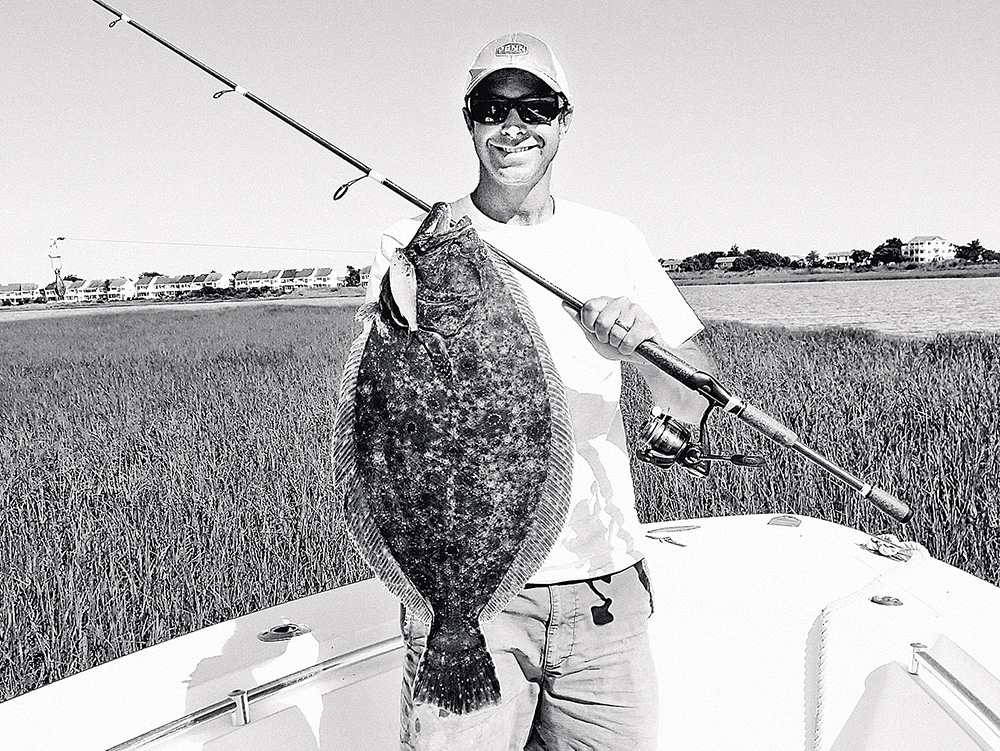
- Expert: Capt. Scott Newhall
- Region: Southern New Jersey
- Species: Summer flounder
“Summer flounder start arriving around the coast in this area in April and during all of May,” says Capt. Scott Newhall. “Then they head into the back bay before reaching the continental shelf for the winter.” A veteran in the guiding biz, Newhall fishes a 21-foot Contender. “In the back bay, you want two hours before and after high tide, since you often get cleaner water then,” Newhall says. “Light winds add to the bite, and I run a drift speed of half to 1 mile per hour.”
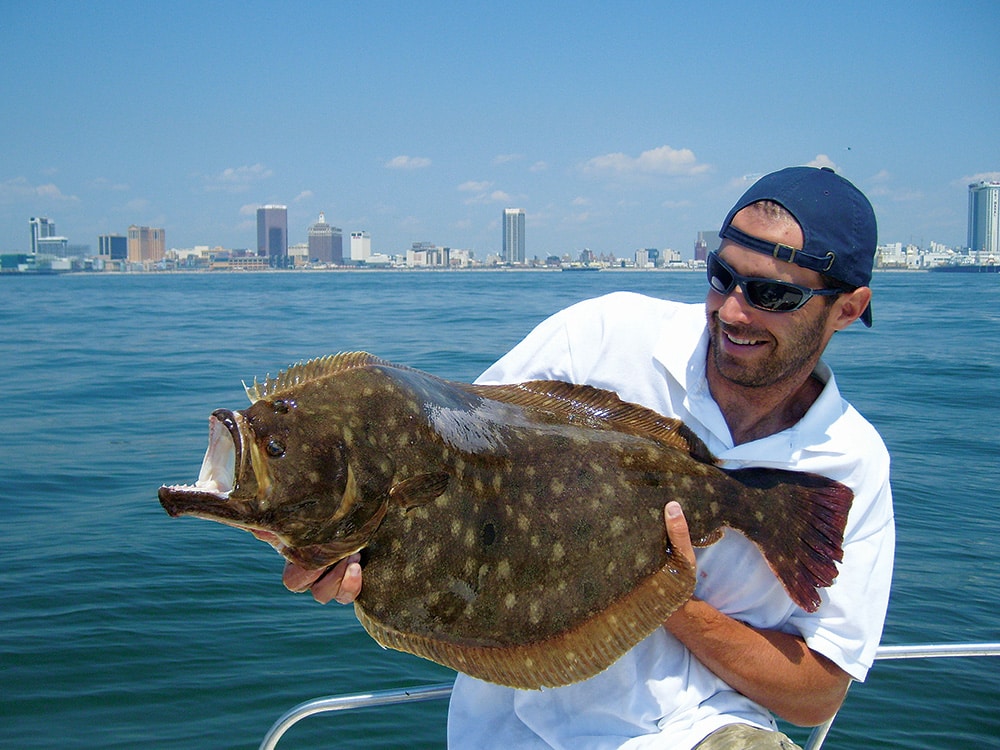
New Jersey Flounder Fishing Tips
- Gulp! Over Gulp!: Go with a single-hook bucktail tipped with a Berkley Gulp!. Ten inches above that, thread a bare Gulp! onto a hook — all colors seem to work well. Vary the retrieve from a long stroke to rapid fire.
- Lots of Live Baits: Effective live baits include minnows, peanut menhaden (pogies or bunker), baby bluefish, striped killifish or mullet, fished on a bare hook.
- Structure on Sand: For ocean fishing, stay tight to structure where the debris or metal meets the sand. If you get a bite and the flounder drops the bait, immediately set it back.
Catching Flounder in North Carolina
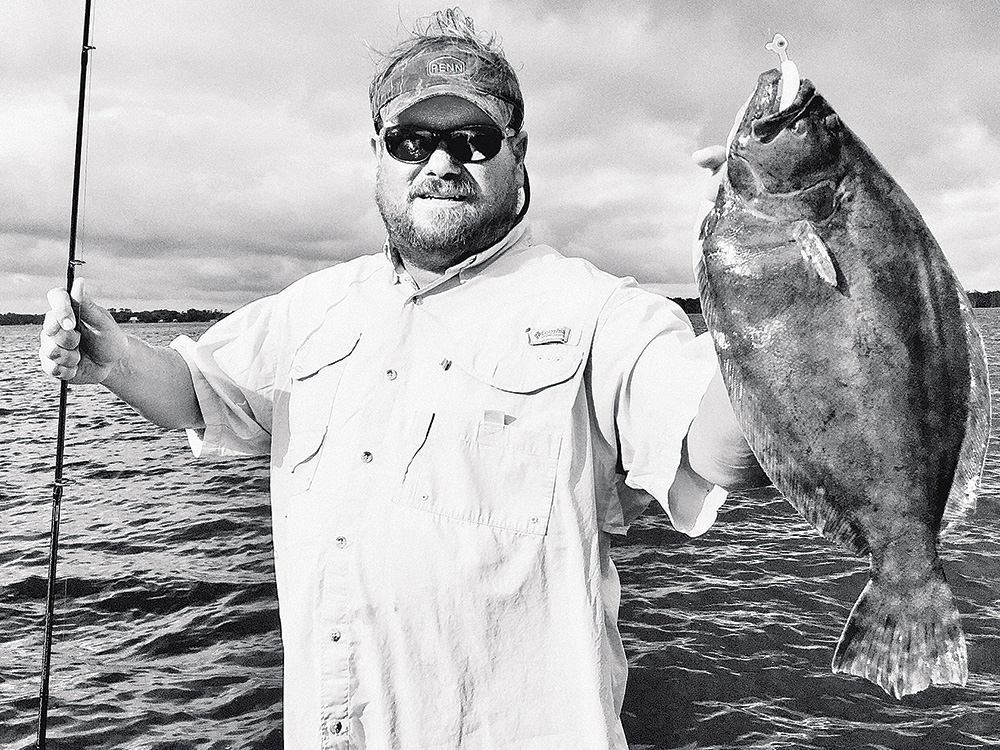
- Expert: Capt. Jeff Onley
- Region: Albemarle Sound
- Species: Southern and summer flounder
Capt. Jeff Onley, who guides from a deep-V Polar Kraft, says the best flounder months in his neck of the woods are May to September, when winds come from the southwest to clear up water and push tides higher. “I prefer braided 6-pound line, up to 12-pound around structure when bigger flounder or stripers are in the mix,” says Onley.
North Carolina Flounder Fishing Tips
- Deploy a Dropper: A dropper rig using a rounded weight and, above it, a hook tied to the line or leader, helps avoid break-offs around structure.
- Best Baits and Lures for Flounder: The best live baits for flounder are croaker or mullet. For strip baits, he likes bluefish, squid or the belly of a gray trout or croaker. When fishing artificials, his go-to list includes Berkley Gulp!, swimming mullets and spinnerbaits.
- Creek-Mouth Wisdom: Target mouths of creeks on the ebb tide and, on the incoming, deeper water over drop-offs and around structure with live baits.
Catching Flounder in Georgia
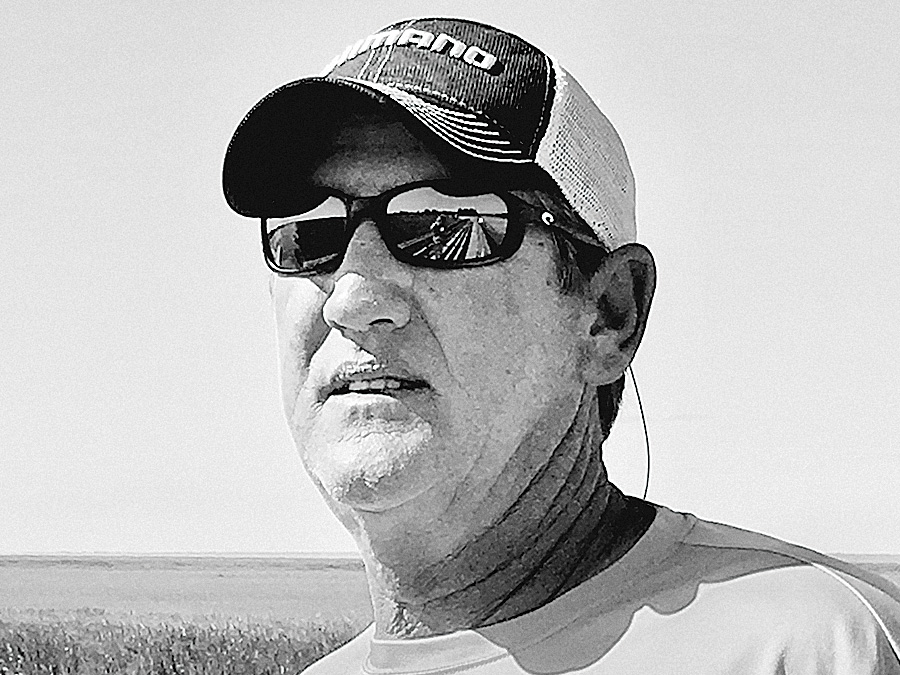
- Expert: Capt. Tim Cutting
- Region: St. Simons Island to northeast Florida
- Species: Southern flounder
A guide since 1990, Capt. Tim Cutting bags flounder year-round from his 20-foot Scout, but does best from June to late fall. “I’m not that big a believer in tidal influence,” says Cutting. “Flounder like clean, salty water and structure near an inlet. They gravitate to wherever the ocean feeds into marshes, jetties, docks and riprap.” Cutting utilizes his trolling motor frequently to cover water. He prefers a Carolina rig with soft plastics, using a sinker as light as possible above the swivel and a short 6- to 15-inch leader to limit bait movement where the bottom is snaggy.

Georgia Flounder Fishing Tips
- Skip the Shrimp: Flounder seldom pass up live croakers, finger mullet, pinfish or menhaden. Junk fish, such as hardhead cats, tend to get to shrimp in this area before flounder do. Soft plastics, such as Berkley Gulps, do well along with spinnerbaits.
- Fewer Fails with a Kahle: Use a Kahle hook for more dependable hooksets. On live bait, wait five to 15 seconds before a hard hookset.
- Think Clearly: When water runs fast, it can become turbid, so concentrate on areas where the bottom isn’t silty. If you can’t see the bottom of your trolling motor, move.
South Florida Flounder Fishing
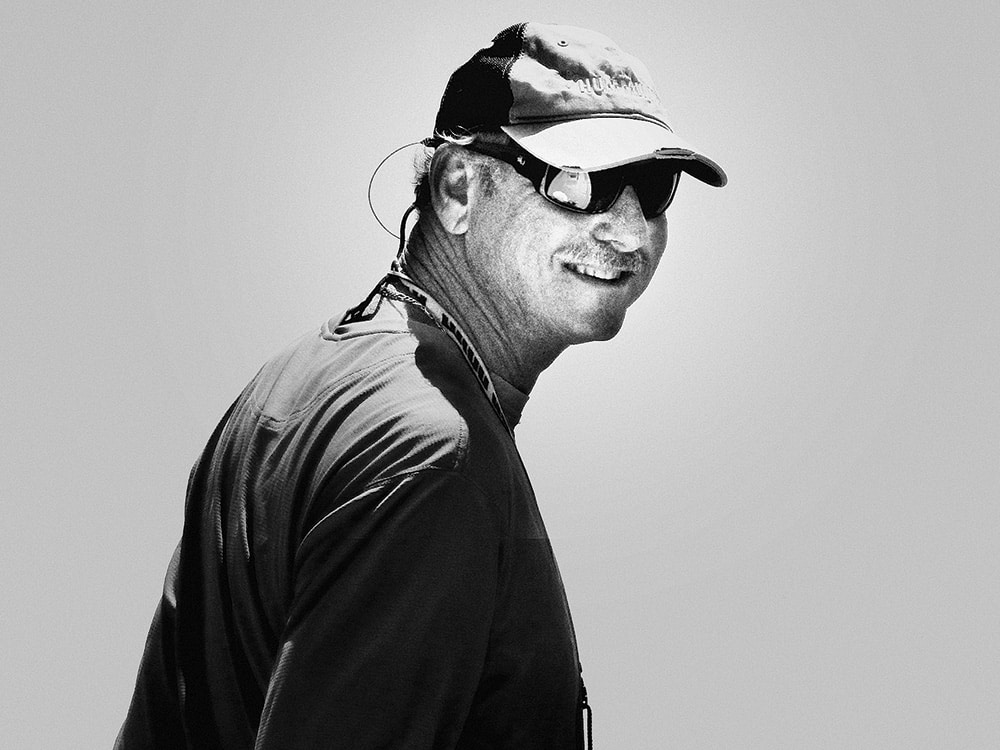
- Expert: Capt. Alan Sherman
- Region: South Florida
- Species: Gulf and summer flounder
A Miami Beach head boat skipper for decades, Capt. Alan Sherman, who runs a 24-foot Pathfinder, knows a thing or two about flounder. “We usually come upon flounder while fishing for other species,” says Sherman, adding that the more frequently encountered summer flounder run 4 to 6 pounds but Gulf flounder are smaller. Late fall through winter, in sandy areas, near rocky bottoms, yields the best flatfish catches. Sherman likes moving water.
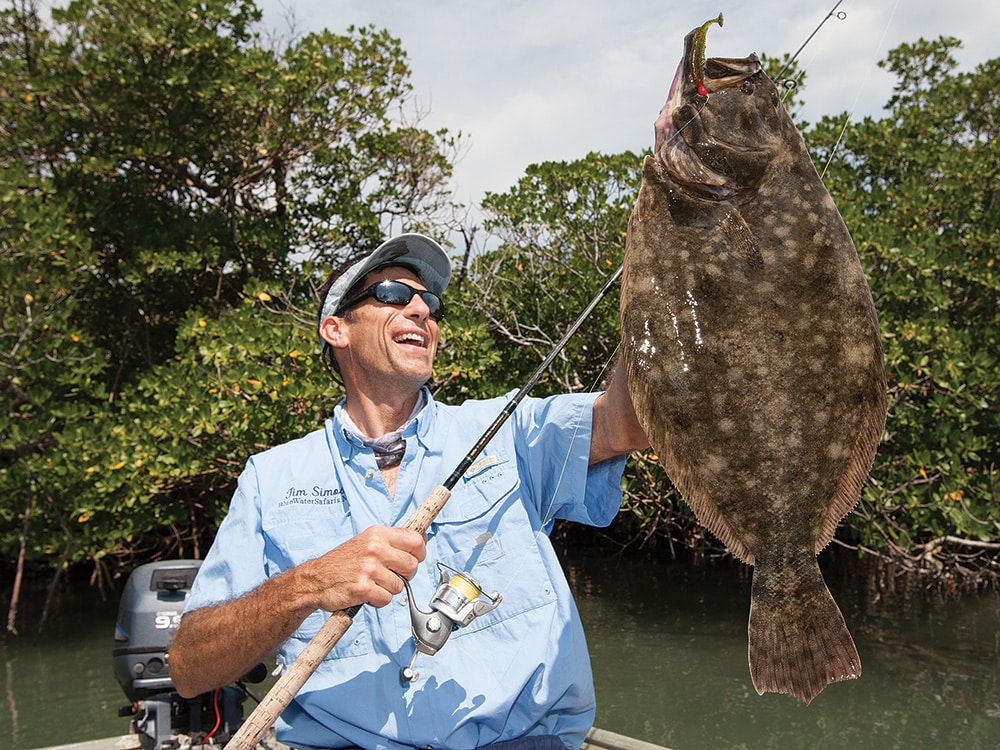
Florida Flounder Fishing Tips
- Supersize Shrimp: In the colder months of winter, fish shrimp, which tend to run large, or else use pilchards hooked through the nose.
- Fish Finger Channels: Target finger channels. Tie the running line via swivel to a 30-pound monofilament leader with a 1/0 short-shank hook, and go with a ¼- to 1-ounce egg sinker, depending on current strength.
- Feel for the Fall: Bounce red or chartreuse jig heads with Gulp! along the bottom. Strikes usually occur as the lure falls.
Gulf Coast Flounder Fishing
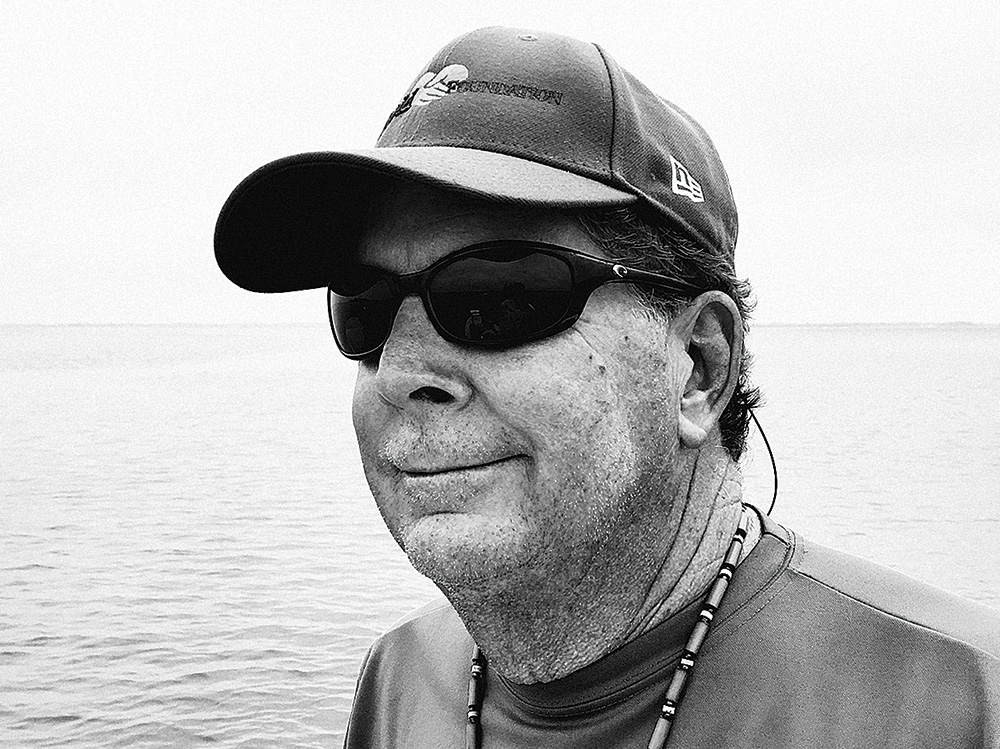
- Expert: Capt. Paul Hajash
- Region: Tarpon Springs to St. Petersburg
- Species: Gulf and southern flounder
Capt. Paul Hajash (pronounced hash), who has been guiding since 1999, fishes a 20-foot Backcountry. “Flounder seem to migrate offshore during winter to spawn in deeper water, and come back when water is between 68 and 78 degrees during spring and fall,” Hajash says. Flounder — especially the bigger doormats — feed more by sight than smell, he adds. “Accordingly, they can see better in clearer water, where they lie hidden until something swims over their heads.”

Gulf Coast Flounder Fishing Tips
- Guide’s Hot Spot: Good areas include the mitigation reefs that run from Sound Key south to St. Petersburg. Flounder congregate in sandy areas in 10- to 15-foot depths just off those reefs.
- Soak a Sardine: Live sardines with a 1/0 to 3/0 hook, fished with just enough split shot to get them to the bottom, are hard to beat. Nearly as good are tiger minnows, chubs and small pinfish. Mullet strips or small pinfish on a lead-head jig also work.
- Cast Up-Current: In Clearwater Pass when the tide is moving in or out, cast up-current and let your bait drift slowly or bump it along the bottom. Oyster bars anywhere often hold promise.
Catching Flounder in Louisiana
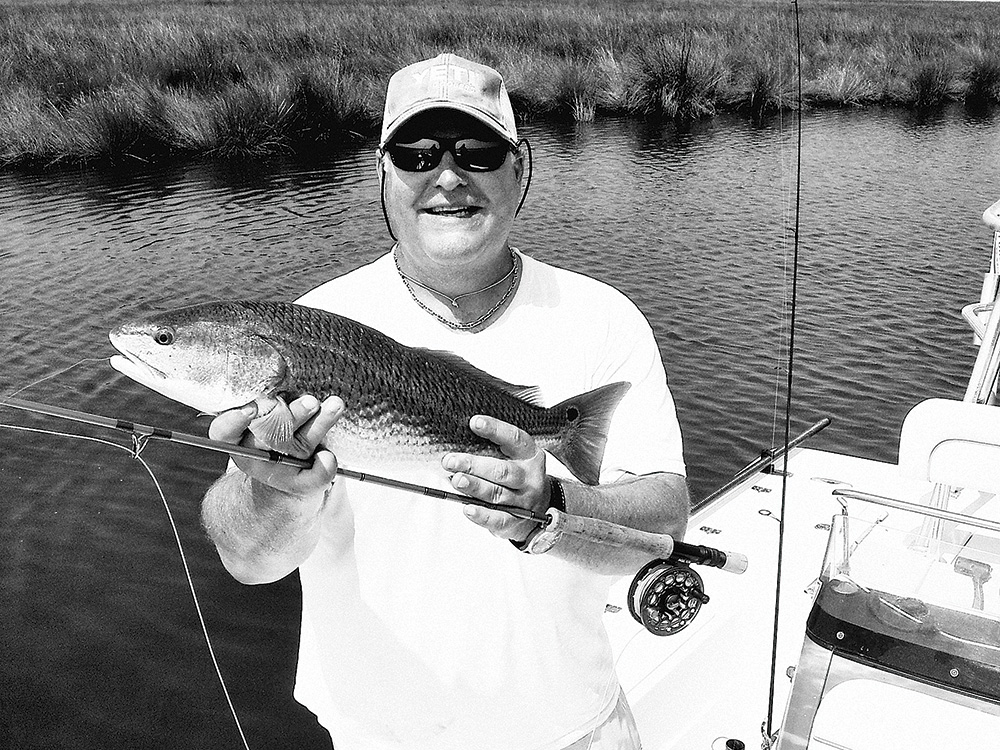
Guide: Capt. Troy Nash Contact: 337-412-5950, Region: South Louisiana Species: Southern and Gulf flounder
Capt. Troy Nash, who’s guided for more than 30 years, employs a 2023 Pathfinder 2500 Hybrid bay boat. “Our best flounder fishing starts in October and November as they migrate into the Gulf to spawn,” he says. “We fish a lot of artificials, such as ⅛- or ¼-ounce wiggle jigs tipped with shrimp.” Nash prefers spin gear with a 20-pound fluorocarbon leader and, if using bait, a 3/0 Owner hook with a shrimp threaded onto it. He adds a small split shot, then bumps the rig along the bottom of bayous and outflows. “You can catch large numbers of flounder in Vermillion Bay and around Marsh Island in the Russell Sage Wildlife Refuge,” he says.
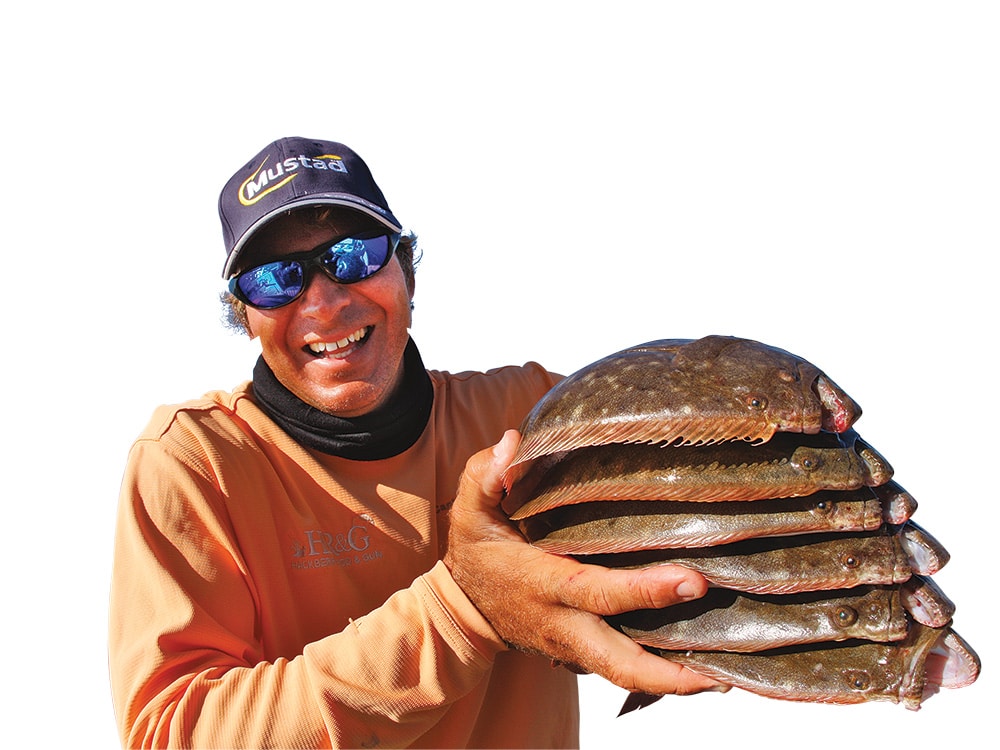
Top Louisiana Flounder Fishing Tips
- Go to the Gators: Look for alligator trails where they enter and exit the water; these create holes where flounder like to nestle. Other points of water flowing in and out of the marshes are good too.
- Follow Slack Tide: Fish the end of high tide, when water starts to slacken, as long as water clarity is decent, then follow the slack tide to the next spot and on and on.
- Flounder on Fly: Fly patterns take plenty of flounder, particularly small poppers, Seaducers and lavender bendbacks. Put a lead wire on the flies to get them below the surface so flounder feel and see the push of water.
Texas Flounder Fishing Secrets

- Expert: Capt. Mike Losoya
- Region: Galveston
- Species: Southern flounder
Capt. Mike Losoya fishes in the marshes and open bays of Galveston. “Around here, we find a decent amount of flounder year-round, but the best runs occur in the marshes from October to November,” says Losoya. He searches for green water that’s neither stained nor crystal clear. Wind doesn’t seem to affect flounder, but he does look for mixed bottoms, “such as sand and mud together with shells around drop-offs in depths from 2 to 20 feet, with the 5-foot range most productive.”
Top Texas Flounder Fishing Tips
- Better with a Baitcaster: Learn to throw a baitcasting rig to maximize precision with just a touch of your thumb to hit the points and run-offs.
- Texas Choice: Live shrimp, mullet, pinfish and croakers work well for those not adept at casting lures, but you should have good action with Berkley Gulps, MirrOlures and the Texas favorite, Corky lures.
- Cover Ground Looking Down: Use your sonar to look for irregularities in the bottom, such as small holes and rocks. Fish eddies in currents. Cover lots of water because flounder will be scattered in potholes as well as open areas.
South Texas Flounder Fishing
- Expert: Capt. Bill Sheka Jr.
- Region: Laguna Madre and Baffin Bay
- Species: Southern flounder
Few guides can match Capt. Bill Sheka’s prominence as one of the most famous fishing personalities in Texas. Now retired, Sheka plied the waters in a 21-foot bay boat for 35 years. “Fishing is best from October to December, when water temperatures fall below 72 degrees, because that seems to get flounder to stop moving,” says Sheka. “Dropoffs are the big key in shallow grass beds, as are points during a push of current.”

South Texas Flounder Fishing Tips
- Pop a Cork: A live shrimp under a popping cork can work magic if popped hard where grass bottom gives way to a channel.
- Twitch Versus Hop: Don’t hop baits along the bottom — they tend to snag too much in these waters. Instead, work your offering with small twitches.
- Cast Master: Precision casting will result in more catches — a difference of only 5 feet from where a guide says to cast can mean the difference between success and a big zero.
The Different Types of Flounder
Gulf Flounder

Summer Flounder
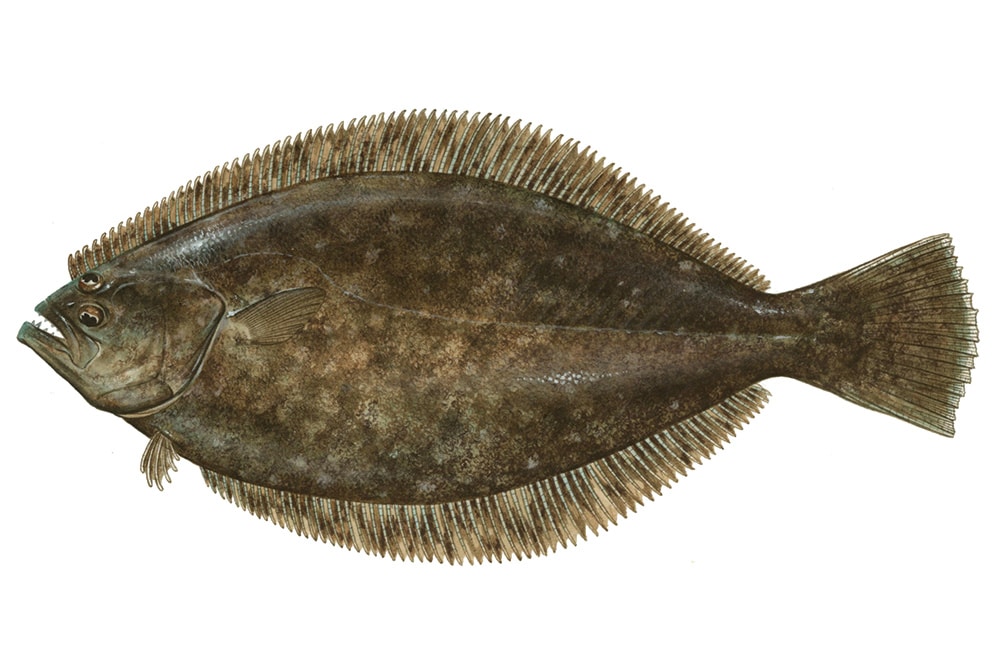
Southern Flounder

Winter Flounder
